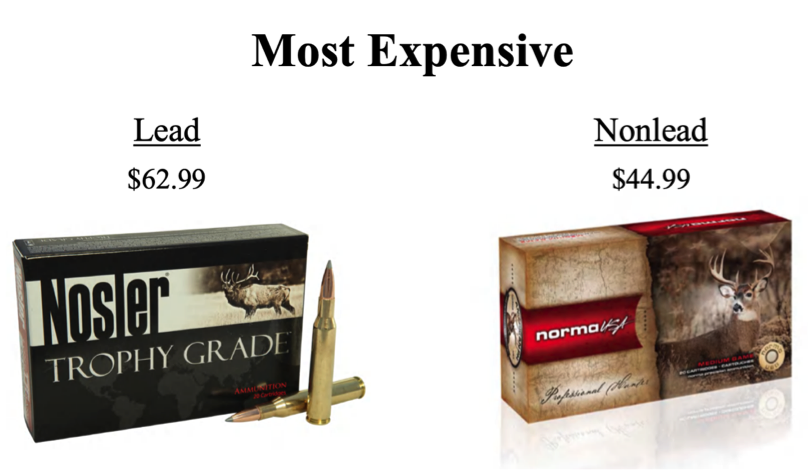
Is nonlead ammo expensive?
June 21st, 2019
Block title
 By: Mike McTeeResearcher
By: Mike McTeeResearcherWhen I give presentations about nonlead ammo, people in the audience often ask about cost. Some worry that nonlead ammo might be so expensive that they’ll be priced out of hunting. But are those worries warranted? I compared the prices of nonlead and lead ammo to find out.
Many people shoot a .270 Winchester cartridge, and so do I, so I’ll focus on ammo for that caliber. Midway USA (www.midwayusa.com) offers a great selection of ammo and a good place to compare prices. To find nonlead options, I searched for “.270 Win”, and in the bar to the left, I checked “Lead Free” under “Product Features”. I ran this search on June 11, 2019.
A box of the least expensive lead ammo is about $10 cheaper than the nonlead ammo. Both boxes had about a 25% discount too. Lead ammo wins.
But hunters seeking the best bullet performance might opt for pricier options. Let’s consider those. The most expensive lead ammo costs $18 more than its nonlead counterpart. Nonlead ammo wins.
But the cheapest and most expensive boxes of ammo don’t tell the full story. Dozens are available at mid-range prices ($25-45/box) where cost differences become negligible.
So, will the cost of nonlead ammo prevent people from hunting? I don’t think so. If I buy the cheapest ammo for my .270 Winchester, I’ll save money with lead. But if I buy anything at mid-range prices, I won’t notice a difference.
Personally, I buy inexpensive lead ammo to shoot at the range. Before hunting season, I sight in my rifle with nonlead ammo. Regardless, compared to the cost of optics, a rifle, and the gas to get me to my hunting spots, the cost of ammo seems like a bargain.

About the AuthorMike McTee
Mike McTee is a researcher at MPG Ranch and the author of Wilted Wings: A Hunter’s Fight for Eagles.
Mike shot his first weapon before he could recite the alphabet. Now, understanding weapons is part of his job. His career took this trajectory after Mike gained a B.S. in Environmental Chemistry. Curious about potential pollution at a historic shooting range at MPG Ranch, he earned an M.S. in Geosciences studying the site. Strangely, the sulfur inside the trap and skeet targets posed the main threat, not the lead in the shotgun pellets. Regardless, lead contamination soon grabbed Mike’s focus. Each winter at MPG Ranch, biologists caught eagles that had lead coursing through their veins. Lead can cripple eagles flightless and even kill them. Mike soon initiated studies on scavenger ecology and began investigating the wound ballistics of rifle bullets, the suspected source of lead.
Mike often connects with the public through his writings and speaking engagements, whether it be to a local group of hunters, or a gymnasium full of middle schoolers. He frequently writes about the outdoors, with work appearing in Sports Afield, The Drake, and Bugle. When he escapes the office, Mike explores wild landscapes with his family, always scanning the horizon for wildlife.
Sign up for Montana’s Nonlead Newsletter (see past editions).
Mike McTee is a researcher at MPG Ranch and the author of Wilted Wings: A Hunter’s Fight for Eagles.
Mike shot his first weapon before he could recite the alphabet. Now, understanding weapons is part of his job. His career took this trajectory after Mike gained a B.S. in Environmental Chemistry. Curious about potential pollution at a historic shooting range at MPG Ranch, he earned an M.S. in Geosciences studying the site. Strangely, the sulfur inside the trap and skeet targets posed the main threat, not the lead in the shotgun pellets. Regardless, lead contamination soon grabbed Mike’s focus. Each winter at MPG Ranch, biologists caught eagles that had lead coursing through their veins. Lead can cripple eagles flightless and even kill them. Mike soon initiated studies on scavenger ecology and began investigating the wound ballistics of rifle bullets, the suspected source of lead.
Mike often connects with the public through his writings and speaking engagements, whether it be to a local group of hunters, or a gymnasium full of middle schoolers. He frequently writes about the outdoors, with work appearing in Sports Afield, The Drake, and Bugle. When he escapes the office, Mike explores wild landscapes with his family, always scanning the horizon for wildlife.
Sign up for Montana’s Nonlead Newsletter (see past editions).
Mike shot his first weapon before he could recite the alphabet. Now, understanding weapons is part of his job. His career took this trajectory after Mike gained a B.S. in Environmental Chemistry. Curious about potential pollution at a historic shooting range at MPG Ranch, he earned an M.S. in Geosciences studying the site. Strangely, the sulfur inside the trap and skeet targets posed the main threat, not the lead in the shotgun pellets. Regardless, lead contamination soon grabbed Mike’s focus. Each winter at MPG Ranch, biologists caught eagles that had lead coursing through their veins. Lead can cripple eagles flightless and even kill them. Mike soon initiated studies on scavenger ecology and began investigating the wound ballistics of rifle bullets, the suspected source of lead.
Mike often connects with the public through his writings and speaking engagements, whether it be to a local group of hunters, or a gymnasium full of middle schoolers. He frequently writes about the outdoors, with work appearing in Sports Afield, The Drake, and Bugle. When he escapes the office, Mike explores wild landscapes with his family, always scanning the horizon for wildlife.
Sign up for Montana’s Nonlead Newsletter (see past editions).
Previous Dispatch:
Next Dispatch:
Other Dispatches
Related Dispatches
Related Research
Probing the lighting sensitivity of image encoders with repeat drone imagery: A case study of plant height estimation
November 11th, 2025
By: Kyle Doherty
2024 publications by the MPG plant-soil feedback group
January 3rd, 2025
























